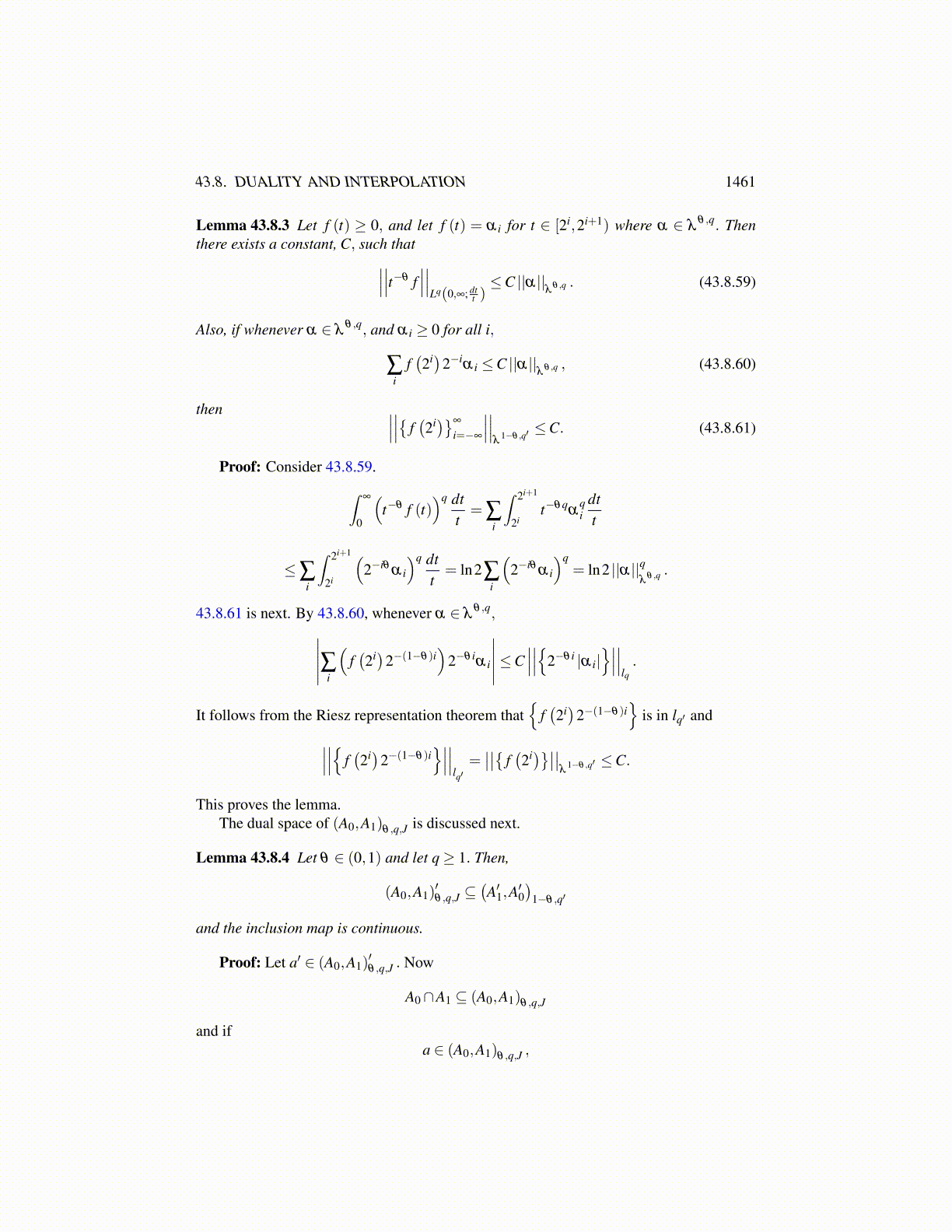
43.8. DUALITY AND INTERPOLATION 1461
This proves the first part of the lemma.Claim: With this definition of the norm in 43.8.54, the operator norm of (a′0,a
′1) ∈
(A0×A1)′ = A′0×A′1 is ∣∣∣∣(a′0,a′1)∣∣∣∣(A0×A1)
′ =∣∣∣∣a′0∣∣∣∣A′0 + t
∣∣∣∣a′1∣∣∣∣A′1 . (43.8.55)
Proof of the claim:∣∣(a′0,a′1)(a0,a1)
∣∣ ≤ ∣∣∣∣a′0∣∣∣∣ ||a0||+ ||a′1|| ||a1|| . Now suppose that||a0||= max
(||a0|| , t−1 ||a1||
). Then this is no larger than(∣∣∣∣a′0∣∣∣∣+ t
∣∣∣∣a′1∣∣∣∣) ||a0||=(∣∣∣∣a′0∣∣∣∣+ t
∣∣∣∣a′1∣∣∣∣)max(||a0|| , t−1 ||a1||
).
The other case is that t−1 ||a1||= max(||a0|| , t−1 ||a1||
). In this case,∣∣(a′0,a′1)(a0,a1)
∣∣ ≤ ∣∣∣∣a′0∣∣∣∣ ||a0||+∣∣∣∣a′1∣∣∣∣ ||a1||
≤∣∣∣∣a′0∣∣∣∣ t−1 ||a1||+
∣∣∣∣a′1∣∣∣∣ ||a1||=
(∣∣∣∣a′0∣∣∣∣+ t∣∣∣∣a′1∣∣∣∣) t−1 ||a1||
=(∣∣∣∣a′0∣∣∣∣+ t
∣∣∣∣a′1∣∣∣∣)max(||a0|| , t−1 ||a1||
).
This shows∣∣∣∣(a′0,a′1)∣∣∣∣(A0×A1)
′ ≤(∣∣∣∣a′0∣∣∣∣+ t ||a′1||
). Is equality achieved? Let a0n and a1n
be points of A0 and A1 respectively such that ||a0n|| , ||a1n|| ≤ 1 and limn→∞ a′i (ain) = ||a′i|| .Then (
a′0,a′1)(a0n, ta1n)→
∣∣∣∣a′0∣∣∣∣+ t∣∣∣∣a′1∣∣∣∣
and also, ||(a0n, ta1n)||A0×A1= max
(||a0n|| , t−1t ||a1n||A1
)≤ 1. Therefore, equality is in-
deed achieved and this proves the claim.Consider 43.8.52. Take a′ ∈ A′0 +A′1 = (A0∩A1)
′ and let
E ≡ {(a,a) ∈ A0×A1 : a ∈ A0∩A1} .
Now define a linear map, λ on E as before.
λ ((a,a))≡ a′ (a) .
If a′ = ã′0 + ã′1,
|λ ((a,a))| ≤∣∣∣∣ã′0∣∣∣∣A′0 ||a||A0
+∣∣∣∣ã′1∣∣∣∣A′1 ||a||A1
=∣∣∣∣ã′0∣∣∣∣A′0 ||a||A0
+ t∣∣∣∣ã′1∣∣∣∣A′1 t−1 ||a||A1
≤(∣∣∣∣ã′0∣∣∣∣+ t
∣∣∣∣ã′1∣∣∣∣) ||(a,a)||A0×A1
so λ is continuous on the subspace, E of A0×A1 and
||λ ||E ′ ≤∣∣∣∣ã′0∣∣∣∣+ t
∣∣∣∣ã′1∣∣∣∣ . (43.8.56)
By the Hahn Banach theorem, there exists an extension of λ defined on all of A0×A1 withthe same norm. Thus, from 43.8.55, there exists (a′0,a
′1)∈ (A0×A1)
′ which is an extensionof λ such that ∣∣∣∣(a′0,a′1)∣∣∣∣(A0×A1)
′ =∣∣∣∣a′0∣∣∣∣A′0 + t
∣∣∣∣a′1∣∣∣∣A′1 = ||λ ||E ′